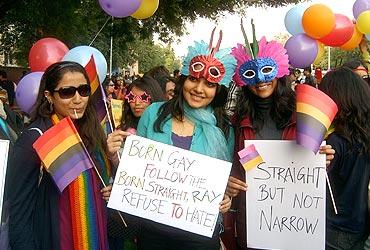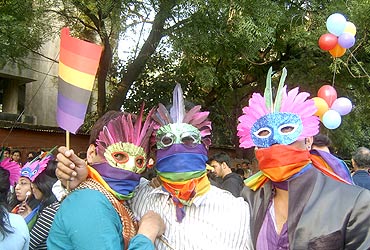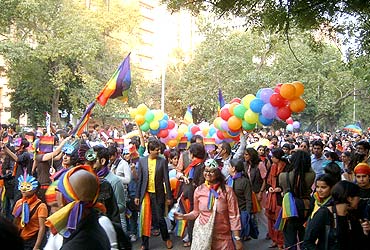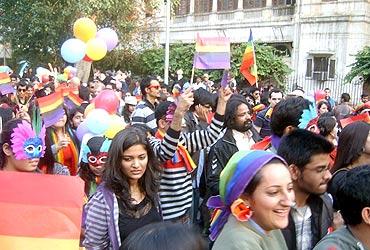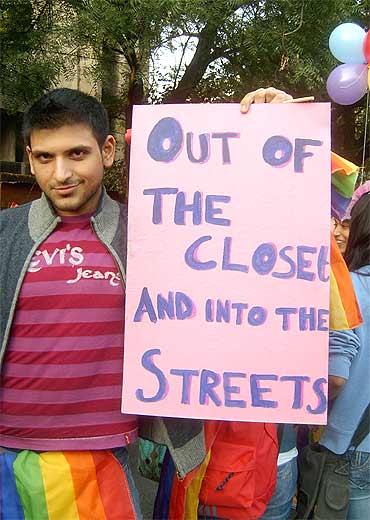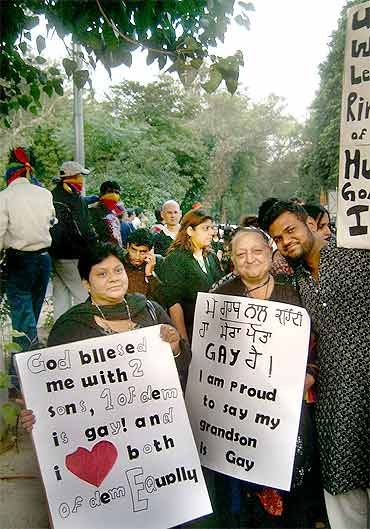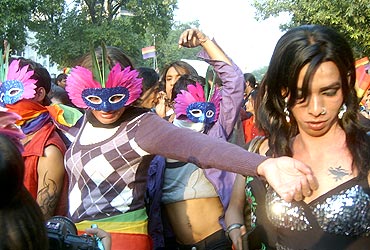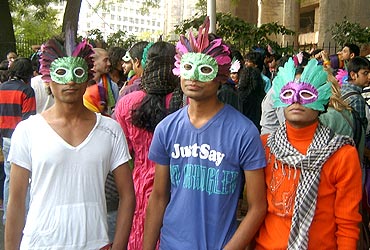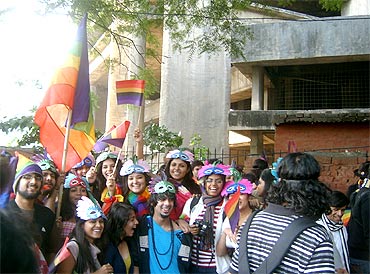 | « Back to article | Print this article |
Gay, colourful and proud on Delhi's streets
This year's colourful and celebratory parade -- starting at the end of Barakhamba Road near Connaught Place and ending next to Jantar Mantar -- was the first march after last year's Delhi high court verdict that struck down the antiquated Article 377 of Indian Penal Code.
Text: Aseem Chhabra. Photographs: Myna Mukherjee
Gay, colourful and proud on Delhi's streets
"It seemed it would never happen in my lifetime. What's surprising is that the rate of change has accelerated. The first year there were fewer people wearing more masks, and today there are more people in fewer masks," he observed.
Gay, colourful and proud on Delhi's streets
As a lot of people observed, this year's parade, with over 2,000 boisterous marchers, included many youngsters -- gays, lesbians, transgenders, but also straight people.
"There is a real change this year," said Gautam Bhan, an activist and one of the organisers of the parade.
"At the first pride parade there were four of us who gave interviews to the media. The numbers of supporting crowds have increased. There are new faces and new people talking to the press and that's fantastic," he said.
Gay, colourful and proud on Delhi's streets
But here it was one big party along Delhi's Tolstoy Marg, with many people dancing to the beats of drums. And the cooler weather made it easier for people to break into dance.
The first pride parade in Delhi had about 800 marchers. Last year's parade, held a few days before the high court judgment, had nearly 1,500 marchers. The number was far higher this year.
Gay, colourful and proud on Delhi's streets
But after last year's Delhi parade, held on a very hot afternoon in June, the organisers decided to shift the march to November, said activist and organiser Mohnish Kabir Malhotra.
Gay, colourful and proud on Delhi's streets
Some read: 'Closets are for Clothes', 'Queer Right are Human Right', 'No Need for Homophobia, Lesbian Suicides, Forced Marriages', 'Jab Pyaar Kiya To Darna Kaya', and 'Out of the Closets and Into the Streets'.
And perhaps the most touching placards were carried by the mother and grandmother of a young gay man.
The mother's placard read: 'God Blessed Me with 2 Sons. 1 of Dem is Gay and I Love Both of Dem Equally!' The grandmother's placard read: 'I Am Proud to Say My Grandson is Gay!'
Gay, colourful and proud on Delhi's streets
An African American man wore a T-shirt that read in Hindi: 'Aadmi Hoon, Aadmi Say Pyaar Karta Hoon (I am a man, I love a man)'.
Many marchers holding a giant rainbow coloured flag were heard shouting: 'Hum Sab Ka Yeh Naara Hai, Homo Hoona Pyaara Hai'!
The rainbow colours, an internationally recognised symbol of gay and lesbian identity, were also seen on the scarves, smaller flags and also a few umbrellas carried by the marchers.
Gay, colourful and proud on Delhi's streets
Delhi policemen and women also watched the parade, often with smiles on their faces.
"The cops have been really nice," said Rahul Sharma, one of the organisers.
Gay, colourful and proud on Delhi's streets
"The few passersby seem curious," Gupta said as he walked in the parade.
"Actually, this part of Delhi is very quiet on a Sunday so you will have to be dedicated to come to protest. But that kind of opposition in an organised manner happens in the US a lot, because of the lobbying groups," he said.
Gay, colourful and proud on Delhi's streets
"Even the casual homophobia doesn't happen here. If more such parades happen, then a few years down the line, there might be protests," said Gupta.
